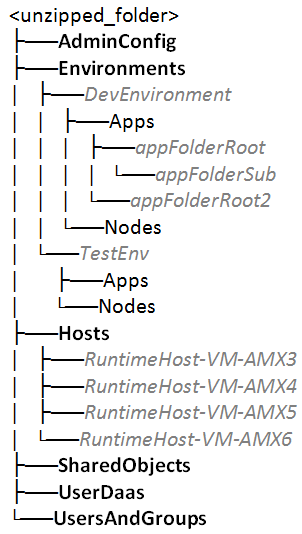Export Archive Directory Structure
After the completion of the export process, the location of the archive or zip file is displayed. By default, the exported archive file on the server is located at <TIBCO Config Home>/admin/<Enterprise_Name>/shared/export.
The default file name (<Userid>_<Timestamp >.zip) has two parts:
If the export process encountered error during the export, the file name is:
<Userid>_<Timestamp>_failed.zip
This indicates that there was an error during the export process and this file could, potentially, have incomplete data.
When you unzip the archive, notice that the exported data comprises of a set of *_build.xml files and matching *_data.xml files. In addition, there are some build.xml files under various folders/sub folders.
Top-level Folders
The top-level folders you would see in typical export data are:
All the folder names highlighted in bold in the above tree structure are top-level folders. They correspond to top-level objects that you selected during export. This means, if you have not selected an object during the export process, it is not displayed in the exported data. For example, if you did not select Hosts during export, the Hosts folder is not seen in the exported archive.
Notice that there are no top-level folders for Nodes and Applications. They are found under each of their parent Environment, as all nodes and applications belong to one environment.
Also notice that certain folders (marked in grey above) have their names derived from the object's name that was exported. For example, DevEnvironment. This folder name came from Environment that was getting exported. This makes reading of exported data easy. Similarly, sub-folders under Host are also named after the Host being exported.

